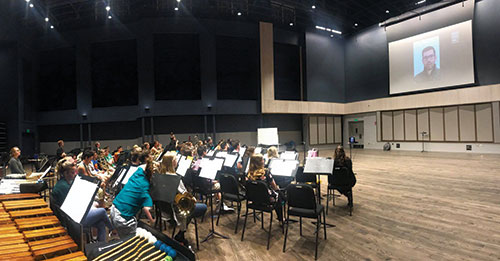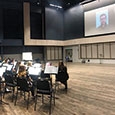
By its nature, studying scores to realize the composer’s intent comes with a degree of allusivity that can be simultaneously full of wonderment and frustration. For many works, it is impossible to ask the composer probing questions. However, when preparing the works of living composers, we ought to make every attempt to get in touch with them and extend this connection to our ensemble members.
Doubt, insecurity, trepidation at the unknown, and a perceived barrier due to logistics or finances might seem like obstacles, but in this digital age, we have the opportunity to connect with others with such simplicity that even my eight-year-old niece can offer me tutorials on the latest video conferencing platforms. Bringing composers into our rehearsals need not be intimidating, difficult, nor expensive. All it takes is some advance planning, modest equipment, and a desire to make meaningful connections.
Planning
When choosing a composer to contact, think carefully about the possibilities that each piece would open up to the ensemble. Any interaction between your students and a composer will be beneficial, but there may be a best choice, depending on the needs of your group.
Consider the sort of interaction that you think will be most beneficial for your players. One option is the composer giving feedback on the ensemble’s performance and interpretation of the piece. Another is a biographical session, in which the composer shares background, approach to writing music, and the context for the piece at hand.
You might also plan a student question-and-answer session. It helps to prepare at least some of the questions in advance by having students submit potential questions to you ahead of time. You should determine the order of the questions students ask.
Timing
There are benefits to bringing in a composer at almost every point in the rehearsal cycle. At the beginning of rehearsing a piece, composers can share their concept of the music with the players before they have gotten deep in to the process. There is potentially less to undo, and it can make for a well-informed and meaningful rehearsal cycle. In the middle of the process, ensembles are prepared enough to perform for the composer and receive critical feedback, with enough time to incorporate any changes. Bringing in a composer near the end of the rehearsal cycle can serve as motivation for the players. It gives them something to look forward to and can make the final preparations for the concert feel really special. The downside is that any changes from the composer will have to be tempered because the performance is so near.
Logistics
In addition to the normal setup of chairs and stands, the room where the session takes place will need to have room for audio/video equipment. Plan how you will position the ensemble so students can see the composer on the screen, hear the speakers, be seen by the composer, and be heard through your microphones.
The ideal microphone scenario is a two-channel stereo set up (two mics- left and right- run through a simple mixer and then in to your computer). You should also project your computer’s audio output through external speakers so your ensemble can hear the composer.
If you can set up an external camera, this will be useful for the composer. Even a simple webcam offers great flexibility with positioning. The alternative is positioning your laptop so its camera captures as much of the ensemble as possible (or having an assistant pan the ensemble with the laptop). Do not be afraid to reach out to your school’s media support staff about audio/video concerns; they tend to be creative problem solvers.
Determine the platform you will use to connect. A few reliable video conferencing options include Zoom, Skype, BlueJeans, and FaceTime. Check with your media specialist to see which platform is supported in your school. You may need to get around a few firewalls if the school has them installed. In my experience, Zoom is quite reliable, and the sound quality is acceptable, but if you use this platform, turn on Original Sound, or the application might interpret your music as a voice and distort it.
Reach Out
I have yet to meet any composers disappointed to hear from conductors or performers who are preparing their music. Most living composers have a website that includes contact information or a web-based form. Send a message to inquire whether the composer has interest in setting up a virtual session with your ensemble.
Agree upon a date and time for the session, keeping in mind that you’ll want to bring your ensemble in shortly before bringing in the composer. Talk through the plan for the session. Send necessary links or digital invitations to the composer. Exchange cell phone numbers in case a glitch occurs on the day of the session.
It is customary to offer any guest an honorarium for taking time to work with the group. Agree upon the honorarium amount up front. It is unwise to procrastinate on this part of the conversation. If you feel awkward, keep in mind that the composer has likely done numerous sessions like these and will be able to guide the conversation. Some composers are forthright with fees, while others do not set a figure. It is helpful to talk to colleagues or mentors who may have worked with the composer before, but it is also reasonable to ask composers what they feel would be an appropriate amount. Be aware of your budget, and if the request exceeds it, put the experience on hold. Although I cannot provide hard numbers, past experience shows me that these sorts of sessions are not budget breakers, and the experience is invaluable.
A Few Days Before the Session
With the equipment you will use for the session, make a test call with a colleague to make sure everything works and you know how to run the program. Familiarity with the program should include knowing how to mute the ensemble while the composer is speaking and vice versa. This is also the time to walk through the session with your students so they know what to expect.
The Day of the Session
Technology tends to fail at the most inopportune moments, so it is critical to allow plenty of time before the session to test everything multiple times and ensure that any glitches have been worked out. Do another test call in the morning before the session.
Be sure that the session is slated to begin a bit after the start of the rehearsal. This gives time to get the ensemble settled and to walk the players through the plan of action again one more time.
During the Session
Smile, relax, and enjoy the experience. Be prepared to lead the conversation, but also be ready to let the composer take charge. Everyone has different styles, and the goal is to be able to facilitate a meaningful back-and-forth between composer and ensemble. Remember that there is often a slight lag, so always pause before speaking after you play, and try not to talk while the composer is talking. With everyone’s permission, it is also a great idea to document the experience.
Follow Up
As with every professional interaction, be sure to follow up on the experience with a thank-you call or email. Make sure to share concert details, especially if there is an option to watch and listen online. Also take the time to follow up with your players. They always have beautiful insights to share. Above all, remember your ultimate goal – to bring composer and player together for a meaningful and musically enriching experience. Relax, be confident, and have fun.







